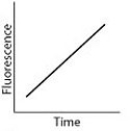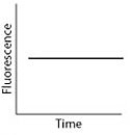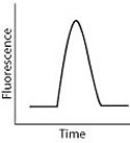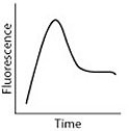Multiple Choice
While DNA microarrays can be used to determine whether or not a gene is expressed in a cell, quantitative polymerase chain reaction (qPCR) can be used to specifically quantify the extent of gene expression in cells and tissues. To perform qPCR, mRNA is extracted from cells and reverse transcribed to complementary DNA (cDNA) . Using fluorescent DNA molecules that recognize specific gene sequences and DNA polymerase, copies of the gene sequence of interest are made. After the copies are made, a fluorescent detector measures the intensity of the fluorescent signal, which is proportional to the number of mRNA transcripts in the cell and corresponds to the level of gene expression in the cell.
-A pancreatic cell normally produces low levels of the protein insulin, but after a meal it produces large levels of insulin before returning to its initial state. Which of the following figures would represent qPCR data obtained from a pancreatic cell that went through this cycle?
A) 
B) 
C) 
D) 
Correct Answer:

Verified
Correct Answer:
Verified
Q17: A gene operon consists of<br>A) a transcribed
Q18: Which possible use of reproductive cloning is
Q19: Which mammal has not yet been cloned
Q20: A single cell, the zygote, can develop
Q21: There is a mutation in the operator
Q23: Adult stem cells have limited therapeutic potential<br>A)
Q24: Two yeast cells, one of type a
Q25: A gene that can cause cancer when
Q26: The expression of the tryptophan operon is
Q27: Which molecules are not required to express